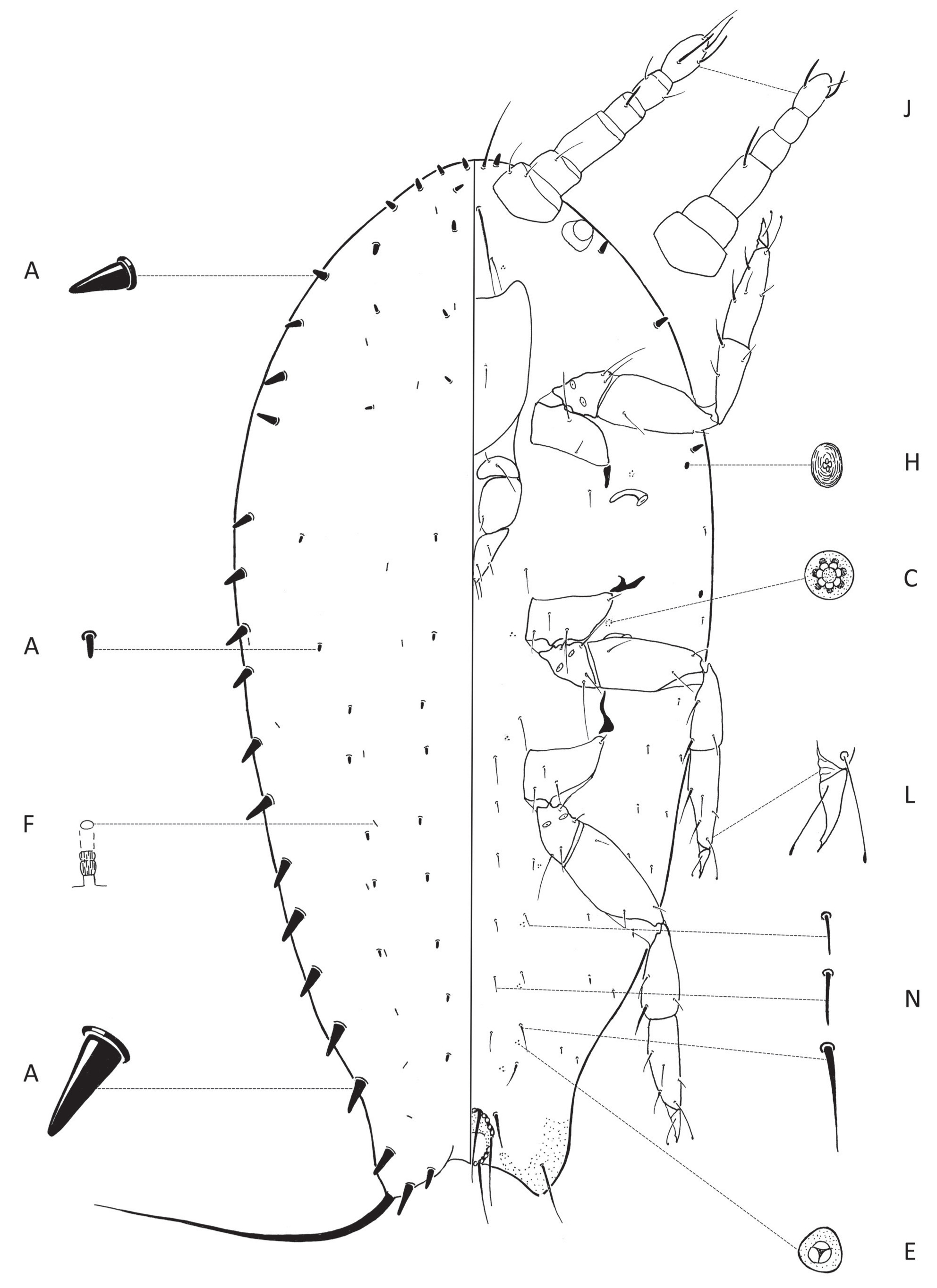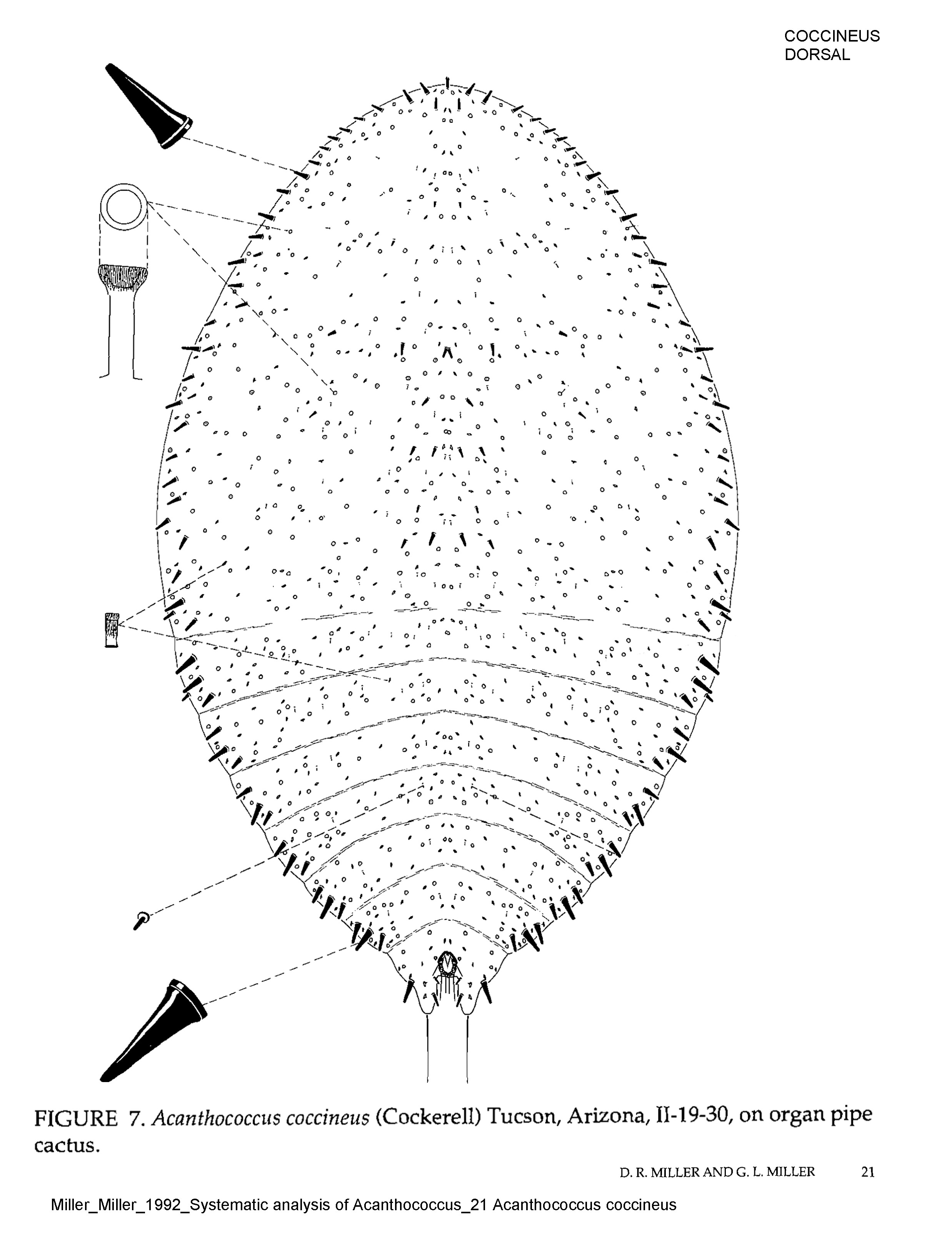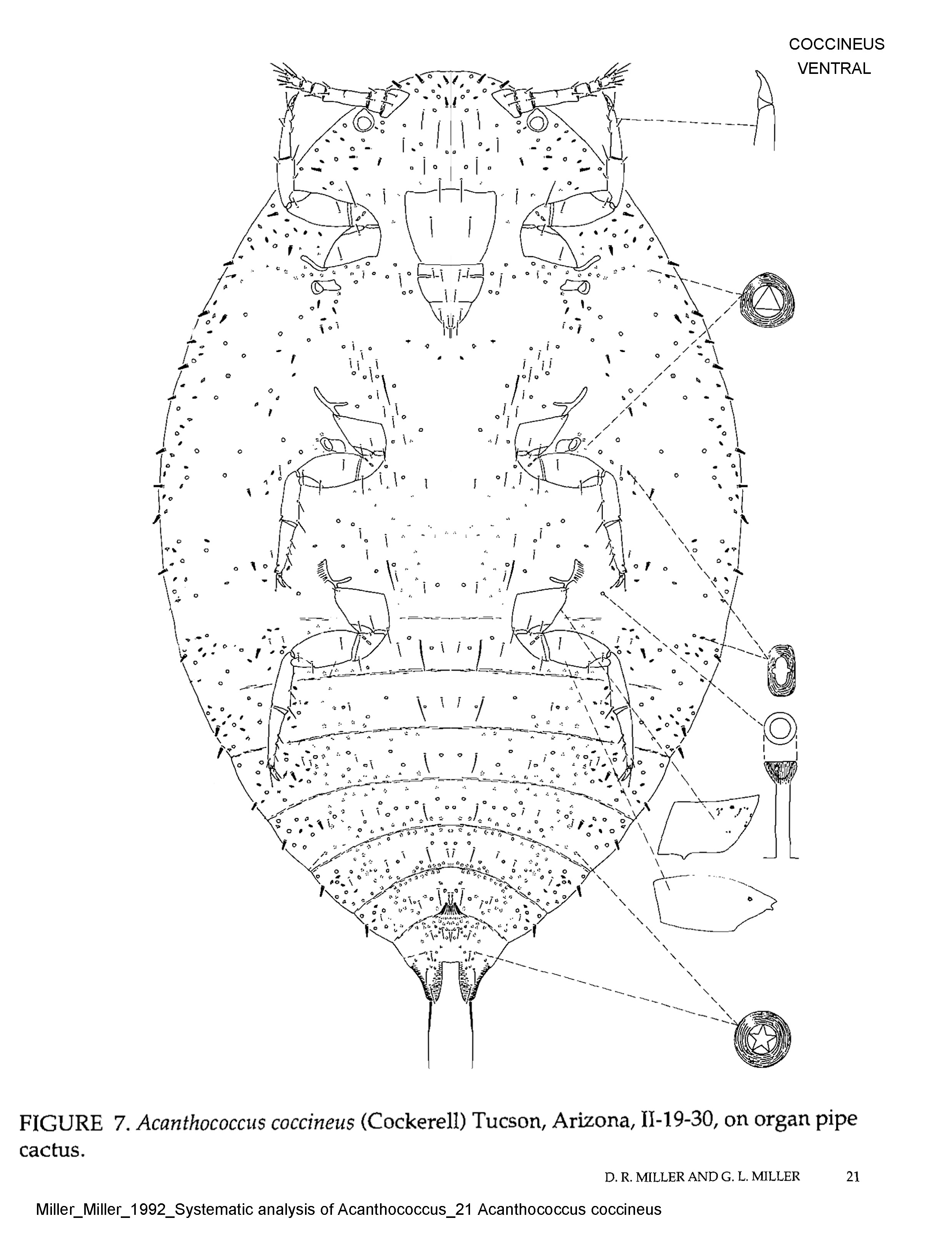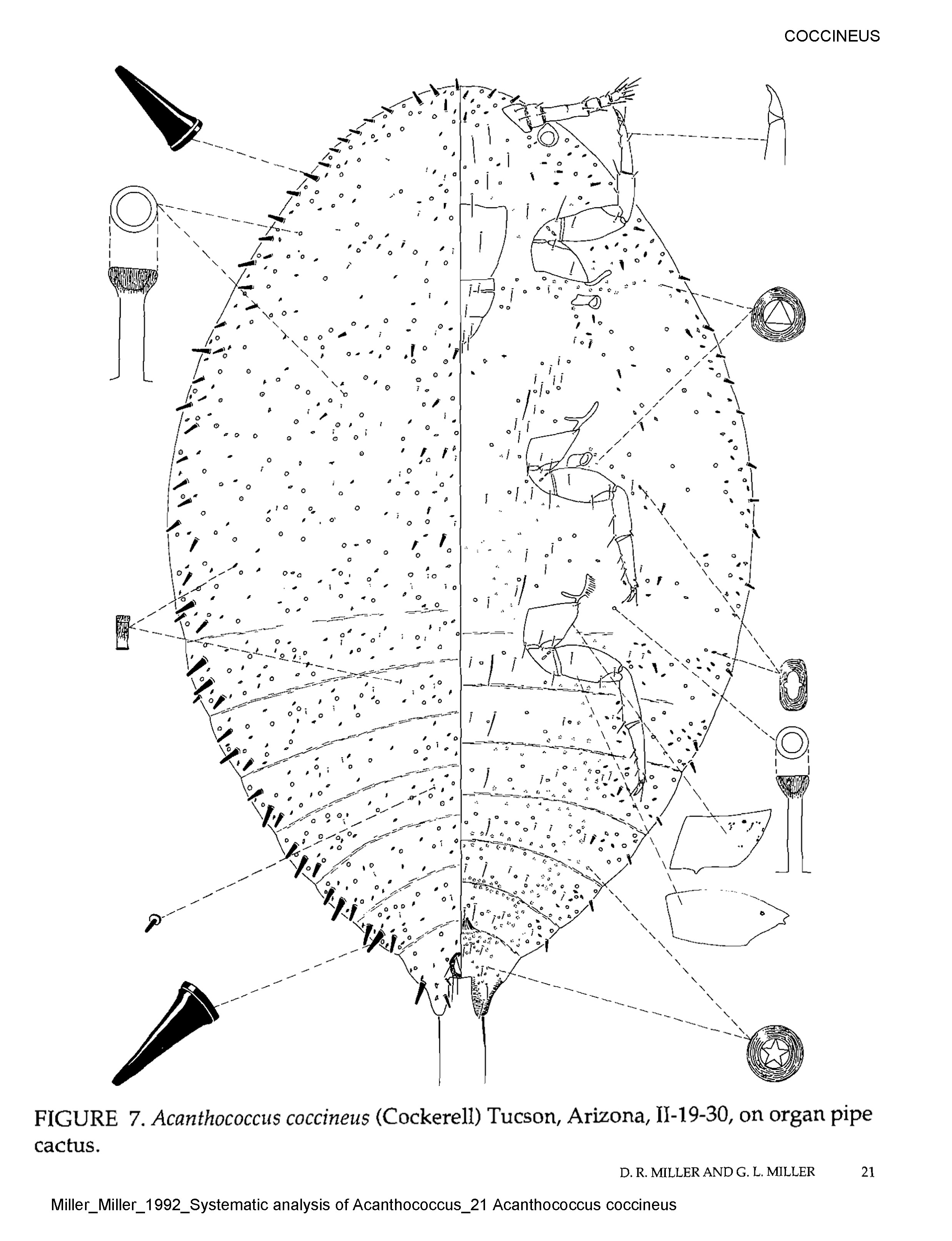Valid Names Results
Acanthococcus coccineus (Cockerell, 1894) (Eriococcidae: Acanthococcus)Nomenclatural History
- Eriococcus coccineus Cockerell 1894k: 204. Type data: UNITED STATES: Nebraska, Lincoln, on a cactus in a greenhouse, 23/05/1894, by Prof. Bruner. Lectotype, female, by subsequent designation (MillerMi1992,19-22). Type depository: Washington: United States National Entomological Collection, U.S. National Museum of Natural History, District of Columbia, USA; accepted valid name Notes: Eriococcus var. lutescens Cockerell is only a color form and should not be considered as a subspecific or specific name (Miller & Miller, 1992). Male specimens are held in the CDAE.
- Eriococcus coccineus lutescens Cockerell 1894k: 204. junior synonym (discovered by Ferris1955a, 116). Notes: Although Cockerell (1894k) considered this to be a color form of Eriococcus coccineus, it has been treated as a subspecies or variety several times (Cockerell 1896b and Ferris 1955a) and based on the rules of the International Code of Zoological Nomenclature must be considered a subspecies.
- Eriococcus saboteneus Kuwana & Tanaka 1922: 215-221. Type data: JAPAN. Unknown type status, unknown, junior synonym (discovered by KozarKaKo2013, 432). Notes: Morrison (1952) states that much of Kuwana's material was destroyed in the 1923 earthquake.
- Dactylopius mammillariae; Lindinger 1931a: 114. incorrect synonymy
- Eriococcus cactearum; Lindinger 1931a: 114. incorrect synonymy
- Nidularia coccinea (Cockerell, 1894); Lindinger 1933a: 108. change of combination requiring emendation of specific epithet for agreement in gender
- Rhizococcus multispinosus; Lindinger 1933a: 114. incorrect synonymy (discovered by Hoy1963, 103).
- Acanthococcus coccineus (Cockerell, 1894); Miller & Miller 1992: 19-22. change of combination Illustr.
- Acanthococcus saboteneus (Kuwana & Tanaka, 1922); Miller & Gimpel 1996: 604. change of combination
- Rhizococcus coccineus (Cockerell, 1894); Kozár 2009: 106. change of combination
- Acanthococcus coccineus (Cockerell, 1894); Hodgson & Miller 2010: 99-100. revived combination (previously published)
- Rhizococcus coccineus (Cockerell, 1894); Kozár, Kaydan, Konczné Benedicty & Szita 2013: 432. revived combination (previously published)
- Acanthococcus coccineus (Cockerell, 1894); Miller & Stocks 2022: 5. revived combination (previously published)
Common Names
- cactus eriococcin Gill1993
- cactus mealybug Gill1993
- cactus spine scale Gill1993
- spine mealybug Gill1993
- woolly cactus scale Steine1987
Ecological Associates
Hosts:
Families: 1 | Genera: 20
- Cactaceae
- Astrophytum | Hoy1963
- Brasiliopuntia brasiliensis | PadillMaNa2016
- Cactaceae | Hoy1963
- Cereus | BenDov2012 MillerMi1992
- Cleistocactus | Hoy1963
- Echinocactus | MillerMi1992
- Echinocactus texensis | BenDov2012
- Echinocereus | MillerMi1992 | (= Wilcoxia)
- Echinopsis | MillerMi1992
- Hylocereus | MillerMi1992
- Mammillaria | MillerMi1992
- Mammillaria parkinsonii | PadillMaNa2016
- Mammillaria sempervivi | PadillMaNa2016
- Neobuxbaumia polylopha | MazzeoSuRu2008
- Opuntia | MillerMi1992
- Opuntia ficus-indica | Foldi2000 | (= Opuntia ficus-barbarica)
- Parodia | JansenAl2023 | (=Brasilocactus)
- Pelecyphora | MillerMi1992
- Peniocereus striatus | PadillMaNa2016
- Pilosocereus pachycladus | PadillMaNa2016
- Rebutia | MillerMi1992
- Rhipsalis | MillerMi1992
- Selenicereus | MillerMi1992
- Thelocactus bicolor | MarottGa1992
Geographic Distribution
Countries: 19
- Australia | Hoy1963
- Brazil | Hoy1963
- Canary Islands | MarottGa1992 MatileOr2001
- Croatia | MastenSi2008
- Czech Republic | Kohler1998
- Egypt | MarottGa1992
- France | Foldi2001 Hoy1963
- Germany | Hoy1963
- Greece | PellizChMi2015
- Hawaiian Islands | Hoy1963
- Israel | MarottGa1992
- Italy | MarottGa1992 PellizDa1997
- Japan | Hoy1963 | KuwanaTa1922
- Mexico
- Chihuahua | Miller1996
- Coahuila | Miller1996
- Morelos | PadillMaNa2016
- Queretaro | Miller1996
- San Luis Potosi | Miller1996
- Tamaulipas | Miller1996
- Veracruz | Miller1996
- Zacatecas | Miller1996
- Netherlands | JansenAl2023
- New Zealand | Hoy1963
- South Africa | MarottGa1992
- United Kingdom
- England | Hoy1963 Malump2006
- United States
- Arizona | MillerMi1992
- California | MillerMi1992
- District of Columbia | MillerMi1992
- Florida | MillerMi1992
- Maryland | MillerMi1992
- Minnesota | MillerMi1992
- Missouri | MillerMi1992
- Nebraska | MillerMi1992
- New York | MillerMi1992
- Texas | MillerMi1992
- Virginia | MillerMi1992
- Washington | MillerMi1992
- West Virginia | MillerMi1992
Keys
- DeeterMiPo2025: pp.230 ( Adult (F) ) [Acanthococcus of Florida]
- MillerSt2022: pp.12 ( First instar ) [Acanthococcus species]
- KozarKaKo2013: pp.392-396 ( Adult (F) ) [Key to species of Rhizococcus]
- TangHa1995: pp.520, 655 ( Adult (F) ) [Rhizococcus species] Key as: Rhizococcus coccineus
- Gill1993: pp.157 ( Adult (F) ) [Acanthococcus species of California] Key as: Acanthococcus coccineus
- MillerMi1993: pp.7 ( Adult (F) ) [Acanthococcus species in the eastern United States] Key as: Acanthococcus coccineus
- MillerMi1992: pp.5 ( Adult (F) ) [Acanthococcus species in the western United States] Key as: Acanthococcus coccineus
- Ferris1955a: pp.97 ( Adult (F) ) [North American species of Eriococcus] Key as: Eriococcus coccineus
Remarks
- Systematics: Slide-mounted adult female with: enlarged setae nearly cylindrical with truncate apices; marginal setae noticeably longer than other setae on dorsum, except for a few medial setae on thorax; 3 enlarged setae on lateral margin of each abdominal segment (Miller & Miller, 1992). Lindinger (1931a) incorrectly treated "cactearum, mammillariae and multispinosus" as junior synonyms of Eriococcus coccineus. These species currently are placed in other families or are treated as valid species of Eriococcus.Slide-mounted adult female with: enlarged setae conical, sides straight, apices rounded, setae all approximately same size, forming 3 longitudinal lines on each side of body except medial line absent on abdomen, 2 or 3 lateral setae on margin of each abdominal segment (Kuwana & Tanaka, 1922). Kozár et al. (2013) distinguished adult females of Acanthococcus species from adult females of Rhizococcus species as follows (character states of Acanthococcus are in brackets): hind tibiae each with five setae (four) and microtubular ducts short (long). Koteja (1974) also indicated that Acanthococcus (=Acanthococcini) differs from Rhizococcus (=Rhizococcus group), with the former having eight pairs of setae on the labium while the latter has nine. Examination of these character states in the publication by Kozár et al. (2013) shows considerable incongruence. Miller & Stocks (2022) considered these character states to be useful in species-level diagnoses, but, until more detailed analyses can be undertaken on the classification of eriococcid genera, they reinstated the assignment of this species to the widespread genus Acanthococcus.
- Structure: Adult female elongate, oval, body usually violet purple with central yellow band, but occasionally crimson red or dull yellow. Ovisac loose and white (Miller & Miller, 1992). The first-instar nymph of Ac. coccineus is most similar to the first-instar nymph of Ac. arenosus by the dorsal medial and mediolateral enlarged setae noticeably smaller than the lateral enlarged setae, the predominant multilocular pores with 3 loculi, and the ventrolateral enlarged setae increasing in size anteriorly. The species differ as follows (character states in brackets are of Ac. coccineus): dorsomedial and mediolateral enlarged setae conical predominantly cylindrical); each femur with five setae (each femur with four setae). (Miller & Stocks, 2022)
- Biology: This species apparently has continuous overlapping generations (Gill, 1993). "Early instars remain attached to fleshy parts of cactus; adult female often migrates to spines of acactus just before oviposition. Male sacs also normally produced on cactus spines (Miller & Miller, 1992).
- Economic Importance: This species appears to be a native of Mexico and southern parts of Texas, New Mexico, Arizona and California. Eriococcus coccineus infests cacti whose transportation all over the world has spread the species, which is now cosmopolitan in nurseries and greenhouses worldwide (Miller & Miller, 1992).
- General Remarks: Detailed description and illustration provided by Miller & Miller (1992).Only description and illustration by Kuwana & Tanaka (1922).
Illustrations
Citations
- AbdRabEv2021: distribution, host, 27
- Arnett1985: distribution, economic importance, 239
- Balach1932e: distribution, 237
- BarbagBiBo1995: distribution, 42
- BenDov1985a: distribution, host, 187
- BenDov1987: distribution, host, 114
- BenDov2012: catalog, distribution, host, 33, 43
- BowenBrJo1982: chemical control, distribution, host, 1
- Brooke1957: distribution, host, taxonomy, 88
- CarnerPe1986: distribution, host, 50, 64
- Cocker1894k: description, distribution, host, taxonomy, 204
- Cocker1894v: distribution, taxonomy, 1052
- Cocker1896b: taxonomy, 323
- Cocker1896h: taxonomy, 18
- Cocker1900i: taxonomy, 595
- CookGu2004: taxonomy, 444
- DeeterMiPo2025: DNA, key, 210, 230
- DowellGiJe2016: distribution, 116
- Elkan1949: host, illustration, taxonomy, 5-6, 31
- Essig1926: distribution, host, 274
- FeltMo1928: distribution, host, 194
- Fernal1903b: taxonomy, 72
- Ferris1920b: taxonomy, 17
- Ferris1955a: description, distribution, host, illustration, taxonomy, 97, 116
- Flachs1931: taxonomy, 75
- Fleury1935: distribution, host, 520
- Fleury1938: distribution, host, 19, 74
- Foldi2000: distribution, host, 81
- Foldi2001: distribution, 305
- FoldiGe2018: distribution, 11
- FullawWh1934: taxonomy, 288
- Germai2008: distribution, 77-87
- Gill1993: description, distribution, economic importance, host, illustration, taxonomy, 157, 162
- GullanCo2001: taxonomy, 95, 97
- GwiazdVaDe2006: phylogenetics, 16
- HardyGuHe2008: phylogeny, 369-373
- HodgsoMi2010: host, taxonomy, 99
- HosnyEz1957: distribution, host, 331-332
- Hoy1962: description, distribution, host, illustration, taxonomy, 32, 58
- Hoy1963: catalog, distribution, host, 80
- Hoy1963: catalog, distribution, host, taxonomy, 114
- Hunt1939: taxonomy, 556
- JansenAl2023: dispersal, host, 28,34
- Kawai1980: distribution, host, taxonomy, 128
- Kawai1980: taxonomy, 128
- King1901i: distribution, host, 232
- Kohler1998: catalog, distribution, host, taxonomy, 374
- Kondo2022b: biology, control, diagnosis, distribution, host, illustration, taxonomy, 403-404
- KondoWa2022a: distribution, host, list, 20
- KondoWa2024: distribution, 2
- KosztaKo1988F: distribution, 275
- Koteja1974b: structure, 76
- Kozar2009: distribution, taxonomy, 106,114
- Kozar2009: distribution, taxonomy, 93
- KozarKo2008a: taxonomy, 148
- KozarWa1985: catalog, distribution, 74
- KuwanaTa1922: taxonomy, 215-221
- KuwanaTa1922: description, distribution, host, illustration, taxonomy, 215-221
- LambdiWa1980: distribution, host, 79
- LepageGi1944: taxonomy, 305
- Lindin1931a: distribution, host, 114, 180
- Lindin1932a: taxonomy, 79
- Lindin1933a: taxonomy, 108
- Lindin1934e: host, taxonomy, 162
- Lindin1935: taxonomy, 148
- Lindin1936: taxonomy, 156
- Lindin1938: distribution, taxonomy, 5
- LongoMaPe1995: distribution, 121
- LongoMaPe1999a: distribution, 148
- MacGil1921: distribution, host, taxonomy, 145
- Malump2006: distribution, economic importance, host, taxonomy, 241-243
- MarottGa1992: distribution, host, taxonomy, 742, 744
- MastenSi2008: catalog, distribution, host, 105-119
- MatileOr2001: distribution, 190
- MazzeoLoPe2014: distribution, 58
- MazzeoSuRu2008: distribution, host, 149-152
- Miller1991a: illustration, 442
- Miller1991b: economic importance, 101
- Miller1996: catalog, distribution, host, 79
- Miller2005: distribution, 491
- MillerGi1996: taxonomy, 604
- MillerGi2000: catalog, description, distribution, economic importance, host, life history, taxonomy, 166-169
- MillerGi2000: catalog, description, distribution, host, taxonomy, 322-323
- MillerMi1992: description, distribution, host, illustration, taxonomy, 5, 19-22
- MillerMi1993: distribution, host, illustration, taxonomy, 7, 23
- MillerSt2022: description, illustration, key, nymph, taxonomy, 12, 15-17
- Nakaha1981a: distribution, host, 405
- NanDeWu2013: phylogenetics, 173-174
- Nishid2002: catalog, 143
- PadillMaNa2016: distribution, host, 557
- PellizChMi2015: distribution, 59
- PellizDa1997: distribution, host, 175
- PellizGe2010a: distribution, economic importance, host, 478,485,505
- PellizKo2011: distribution, 67
- Pember1945: distribution, host, 224, 231-2, 461
- PerezGCa1985: distribution, 317
- PooleGe1997: distribution, 354
- PrinslMy1981: biological control, 154
- RossHaOk2012: phylogeny, taxonomy, 199
- SilvadGoGa1968: catalog, distribution, host, 159
- Steine1987: description, 6
- Stimme1987: distribution, host, 23
- StoetzMi1979: catalog, taxonomy, 10
- TangHa1995: description, distribution, host, taxonomy, 520, 524, 655
- VeaGr2015: phylogeny, 64
- VeaGr2016: evolution, 4
- VonEll2025: distribution, 26
- Whitne1933: distribution, host, 66
- Willia2017a: catalog, list of species, 236
- WilliaBe2015: taxonomy, 165
- Wise1977: distribution, taxonomy, 96
- Zahrad1968: distribution, host, 11
- Zahrad1977: distribution, 121
- Zahrad1990c: distribution, host, 16
- Zimmer1948: description, distribution, host, illustration, taxonomy, 283, 287-90






